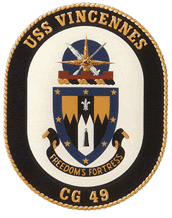|
 Shield: Shield:
The
three divisions of the shield represent the three circumnavigations
of the earth made by the first vessel to bear the name Vincennes;
contain allusions to activities of these expeditions. The indented
fess line represents the ice of the Antarctic continent which was
discovered and named by Lieutenant Charles Wilkes, Captain of the
Vincennes in 1840.
The
Antarctic wastes and icebergs are alluded to by the white area in
the center base which bears a lead line weight of the early 19th
century period; referring to the new data in charts and cartography
gathered by the surveys made during expeditions with the Vincennes
as flagship.
The silver fleur-de-lis refers to the French origin of the name
Vincennes and the fort in Indiana after which the ship was named.
The eight gold stars on a light blue border represent the Battle
Stars awarded to CA-44 and CL-64 during World War II and refer again
to the State of Indiana, whose flag bears gold stars on a blue field.
The Navy is represented on the shield by dark blue and gold, colors
usually associated with the Navy.
Crest:
The
embattled wall recalls the Fort Vincennes in Indiana. Its color,
red, refers to battle. The three embattlements refer to the three
earlier vessels to bear the name Vincennes. The compass rose represents
global navigation and exploration. The shamrock is a reference to
the new ship's distinction as the third of its class and recalls
the botanical surveys of the first Vincennes. The guided missile
and rifle represent new and old weaponry carried by the latest and
first Vincennes. The blue disc is a reference to the Antarctic skies
and the first Vincennes' explorations.
|


 Shield:
Shield: